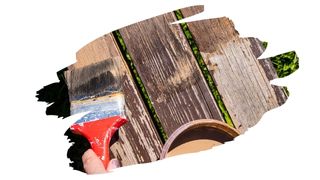Is that wood stain still feeling tacky to the touch? You’ve waited hours — maybe even days — and yet it still doesn’t look like it’ll be drying any time soon.
If this sounds familiar, then before you give up and start again, why not take a quick look at our post below. Why? Well, because in this post you will find out the three most common reasons why that wood stain isn’t drying.
You will also discover how a bit of Mineral Spirit could solve your wood stain drying problems. And keep reading to learn the difference between drying and curing — and how it relates to tacky wood stain.

This post may contain affiliate links to products that we receive a commission for (at no additional cost to you). Learn more here.
Why Is My Oil-Based Wood Stain Not Drying?
When it comes to tacky wood stain, the problem is usually less about it’s failure to dry. Instead, the problem lies in the fact that it is struggling to cure.
You see, penetrating oil-based wood stains contain (for the most part) two key ingredients — binders and pigments. And they might include some fast-drying solvents to help thin them out and speed up drying overall.
Now, the binding ingredient itself can vary from brand to brand. Some wood stains use varnish as their binding ingredient. While others use polyurethane, or maybe even Linseed oil, as a binder instead.
Regardless, the main job that all of those different binding ingredients do, is the same. And that job is to bind that pigmented color to wood fibers.
But, in order to do that, those binders need time to dry and cure evenly. If they don’t, you’re going to be left with tacky-feeling stain.
Related Post: Can You Really Go Mixing Stain With Polyurethane (For Hardwood Floors)?
So What Is The Difference Between Drying And Curing?
The difference is chemistry.
Drying is all about evaporation. The solvents in that wood stain evaporate away, leaving behind a film made up of binders and pigmented color.
However, curing involves a chemical reaction. And that reaction changes the very substance of that binding ingredient. Namely, in the case of oil-based wood finishes, it turns it from a film into a solid resinous substance.
Plenty of natural wood finishes, such as Tung oil, rely on slow-curing to give wood water-resistant coverage. In fact, we dive more into why the notoriously slow-drying Tung oil is so tricky to work with, in our post here: Tung Oil Not Drying? (3 Simple Ways To Fix It)
Now, while evaporation can happen fairly quickly (usually within a few hours), curing often takes longer. And everything, from humidity to temperature to how much wood stain you applied, can effect how quickly it takes for a stain to cure.
Is That Why My Wood Stain Is Still Tacky After A Week?
For the most part, yes. Anything that interferes with either the drying or curing process can leave wood stain tacky indefinitely.
But in ideal conditions, wood stain will dry given enough time (12 to 24 hours depending on your particular brand).
Related Post: Can You Apply Wood Stain Over Wood Hardener? (Best Practice Revealed!)
But Why Exactly Is My Stain Still Tacky? What Could Be Preventing It From Drying?
If that wood stain won’t dry, it’s typically down to one of the three following reasons:
1). It’s Too Cold
Wood stains need at least a bit of heat around them in order to dry.
If the area is too cold, (i.e. below room temperature), this will obviously lead to wood stain taking longer to dry.
2). There’s Too Much Of It
This is usually the most common reason.
Any over-application of wood stain makes it really difficult for it to dry fast. This can happen when you haven’t rubbed the stain right down into that wooden surface. Or if you haven’t wiped away any excess stain (after application).
3). There’s Too Much Humidity
Last but not least, if the environment is very humid, moisture in the air will make it difficult for wood stain to dry quickly.
In fact, if relative humidity (RH) is 85% or more, then wood stains simply won’t dry at all.
Now, that’s the bad news. The good news is that you can simply use a dehumidifier to maintain a 45% RH to 55% RH ideal humidity range. This should be enough to solve the problem of humidity preventing wood stain from drying.
Will Tacky Stains Eventually Dry On Their Own?
Generally, if it still feels tacky after a day or so, then it’s unlikely to change — at least not without some extra help.
However, this is only the case with oil-based wood stains.
You see, there are wood stains that blend pigments and solvents — yet they include no binding ingredient at all. In these instances, binder-free wood stains will stay tacky indefinitely, regardless of what you do to fix them.
And why is that? Well, because once the solvents have evaporated, all thats left behind is pigment. And no amount of waiting around is going to get congealed pigment to ‘dry’ on its own.
So How Do You Make Wood Stain Dry Faster (If Humidity And Temperature Aren’t The Problem)?
At this point, your next step is to try and thin out the wood stain.
Wiping stain down with a lint-free rag, (that’s been soaked in Mineral Spirits), will soften up tacky wood stain.
This will then make it easy for you to remove any excess wood stain that may be preventing it from drying.
Quick Step-By-Step Guide To Thinning Out Tacky Wood Stain
Step 1: Put on some protective gloves.
You are going to be dipping your hands into a solvent, so let’s stay safe.
Step 2: Soak a rag (ideally a lint-free rag) into mineral spirits.
Step 3: Run the soaked rag over the tacky wood stain.
Afterwards, wait for 2-3 minutes.
The mineral spirit solvent will soften up that too-thick wood stain.
Step 4: Using a putty scraper (NEVER fine steel wire wool) remove as much of the tacky stain as you can.
But you only need to get rid of the excess congealed stain on the surface. Don’t remove all of that wood stain color.
Step 5: Get another separate fresh clean lint-free rag, and soak it in mineral spirits.
Squeeze off the excess mineral spirit so that the rag is left damp, not soaked.
Step 6: Run the damp rag over the surface.
Remove the last of any tacky stain left behind.
Related Post: Can You Use Mineral Spirits Before Wood Stain?
OK. But Why Is The Stain Dry In Some Areas And Only Tacky In Certain Spots?
When wood stain dries unevenly, that indicates that the problem isn’t with the stain itself. Instead, the problem is the wooden surface underneath.
Wood stains work best on clean uncontaminated wooden surfaces. If there are any sections of that surface that still have any old finish on it, then wood stains will struggle to dry on that section.
This issue can happen a lot when you refinish old furniture.
You can do all you can to remove the old finish or stain prior. But, if you haven’t removed it all, and then apply stain over it, those contaminated sections will reject the stain color.
If surface contaminants are the reason why your stain isn’t drying, you’ll have to strip off the stain completely and start again.
This can be tricky though, especially if the stain has already sunk right down into wood grain.
But, you might still have a chance at stripping off that stain by thinning it out with mineral spirits. We cover more on this topic here: Will Mineral Spirits Be Enough To Remove Gel Stain?
To Wrap Up, Here Are The 3 Key Takeaways From This Post…
- 1). Wood stains can remain tacky due to high humidity environments, or due to over-application.
- 2). You can fix tacky oil-based wood stains by thinning them out with mineral spirits.
- 3). However, wood stains that do not contain a binding ingredient are much more difficult to fix. Often, you’ll have no choice but to strip off these particular tacky stains completely, and start all over again.
References:
Arminger, Benjamin, et al. “On the drying behavior of natural oils used for solid wood finishing.” Progress in Organic Coatings 148 (2020): 105831.



